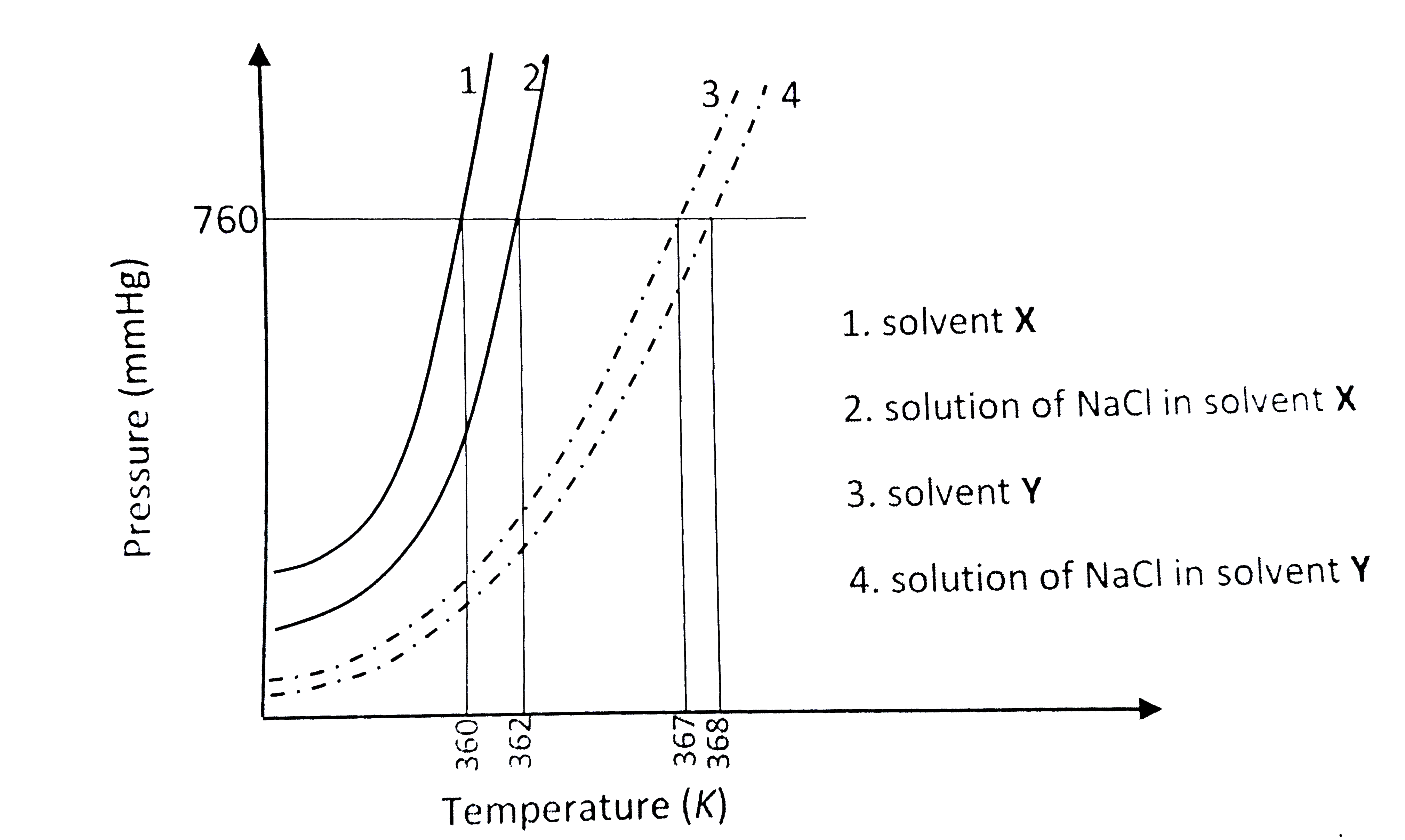The plot given below shows P-T curves for two solvents X and Y and isomolal solution of NaCl in these solvents. NaCl completely dissociates in both the solvents
1. Solvent X
2. Solution of NaCl in solvent X
3. Solvent Y
4. Solution of NaCl in solvent Y

On addition of equal number of moles of a nonvolatile solute S in equal amount (in kg) of these solvents, the elevation in boiling point of solvent X is three times that of solvent Y. Solvent S is known to undergo dimerisation in these solvents. If the degree of dimerisation is 0.7 in solvent Y, the degree of dimersion in solvent X is
The correct Answer is:0.05
With NaCl undergoing 100% dissociation
(ΔTb)x=2(Kb)xm, (ΔTb)y=2(Kb)ym
From figure (ΔTb)x=362−360
and (ΔTb)y=368−367
With solute undergoing dimerisation
(ΔTb)x=(1−x2)(Kb)xm
(ΔTb)y=(1−0.72)(Kb)xm
Given that (ΔTb)x(ΔTb)y=3
Topper's Solved these Questions
- BOOK - RC MUKHERJEECHAPTER - DILUTE SOLUTION AND COLLIGATIVE PROPERTIESEXERCISE - Objective problems36videos
DILUTE SOLUTION AND COLLIGATIVE PROPERTIES
- BOOK - RC MUKHERJEECHAPTER - DILUTE SOLUTION AND COLLIGATIVE PROPERTIESEXERCISE - Objective problems36videos
DILUTE SOLUTION AND COLLIGATIVE PROPERTIES
- BOOK - RC MUKHERJEECHAPTER - CHEMICAL THERMODYNAMICSEXERCISE - Objective problems58videos
CHEMICAL THERMODYNAMICS
- BOOK - RC MUKHERJEECHAPTER - ELECTROLYSIS AND ELECTROLYTIC CONDUCTANCEEXERCISE - Objective Problems39videos
ELECTROLYSIS AND ELECTROLYTIC CONDUCTANCE
Similar Questions
The plot given below shows P−T curves (where P is the pressure and T is the temperature) for two solvents X and Y and isomolal solutions of NaCl in these solvents. NaCl completely dissociates in both the solvents.

On addition of equal number of moles of a non-volatile solute S in equal amount (in kg) of these solvents, the elevation of boiling point of solvent X is three times that of solvent Y. Solute S is known to undergo dimerization in these solvents. If the degree of dimerization is 0.7 in solvent Y, the degree of dimerization in solvent X is ____.View SolutionThe plot given below shows P – T curves (where P is the pressure and T is the temperature) for two solvents X and Y and isomolal solutions of NaCl in these solvents. NaCl completely dissociates in both the solvents.

On addition of equal number of moles of a non-volatile solute S in equal amount (in kg) of these solvents, the elevation of boiling point of solvent X is three times that of solvent Y. Solute S is known to undergo dimerization in these solvents. If the degree of dimerization is 0.7 in solvent Y, the degree of dimerization in solvent X is ______________.View Solution
Knowledge Check
- Question 1 - Select One or More
Partial pressure of solvent in solution of nonvolatile solute is given by equation,
AP=x2P∘BP∘=xPCP=x1P∘DP∘=x1P - Question 2 - Select One
Vapour pressure of a solvent containing nonvolatile solute is:
Amore than the vapour pressure of a solventBless than the vapour pressure of solventCequal to the vapour pressure of solventDnone - Question 3 - Select One
Number of moles of a solute per kilogram of a solvent is called
AmolarityBmolalityCNormalityDformality
Vapour pressure of a solvent containing nonvolatile solute is:
View SolutionExplain solute solvent and solution ?
View SolutionOf the two solvent H2O and D2O,NaCl dissolves
View SolutionThe number of mole of solute per kilogram solvent is called -
View SolutionIf solute and solvent interactions are more than solute- solute and solvent -solvent interactions then
View Solution

